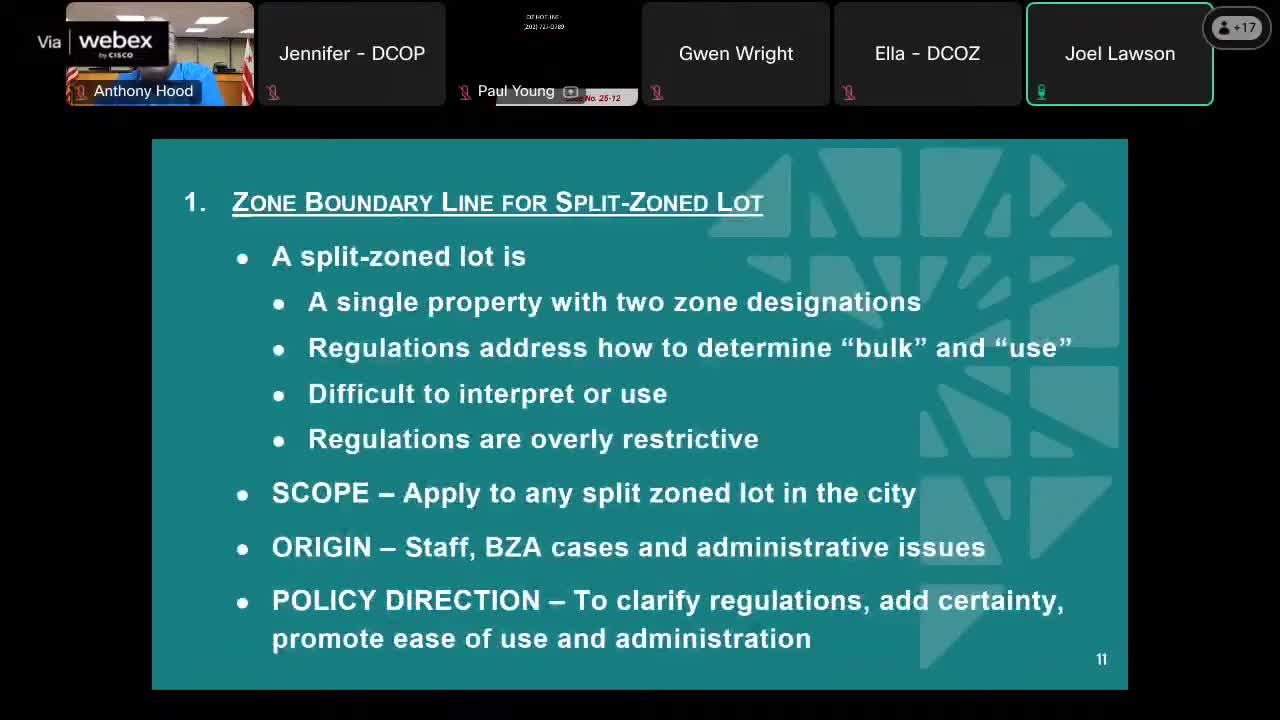Zoning panel considers easing split-zone rules to let lower-density FAR move to denser portion of lots
October 31, 2025 | Office of Zoning, Agencies, Organizations, Executive, District of Columbia
This article was created by AI summarizing key points discussed. AI makes mistakes, so for full details and context, please refer to the video of the full meeting. Please report any errors so we can fix them. Report an error »

Office of Planning proposed a clarification to the rules governing split-zone lots that would allow the density mathematically generated by the lower-density portion of a split lot to be used on the more permissive portion of that same parcel.
Joel Lawson, associate director for development review at the Office of Planning, told the commission the change is primarily a clarification and limited expansion of an existing process: "we're proposing to allow that for the entire portion of the property zone, zoned R 2," he said, describing how the current practice restricts transfers from only the first 35 feet of the more restrictive portion but leaves the remainder effectively unused.
Why it matters: Supporters said the amendment would convert otherwise unusable taxed land into housing capacity without changing a property's permitted height, setbacks or other bulk controls. Noel Wurst of the Office of the Attorney General said OAG supports this element of the package as a way to "remove disincentives to housing development" and to provide consistent administration across BZA cases.
Opponents, including the Committee of 100 and several ANC representatives, cautioned that the change could be interpreted as a shift in policy if it is not clearly limited to density (FAR) and not to building bulk or form. Committee of 100 representatives urged retaining a special-exception standard that explicitly evaluates "present character and future development of the neighborhood" rather than substituting the general adverse-impact special-exception standard.
Details and limits: OP stressed that the measure does not alter other bulk controls. As Lawson explained in response to commissioners' questions, when a property uses the transferred density the height, lot-coverage, setback and other bulk rules that apply in the more permissive zone still constrain what can be built. The proposal relocates the split-zone provision in the zoning text (to Subtitle C) to improve clarity and administration.
Next steps: The commission did not vote tonight. The item remains under public hearing as part of case 25-12 and staff said they will provide additional documentation in the record. ANC and Committee of 100 concerns about definitions of "bulk" versus "density" and the applicable special-exception standard were left on the record for further consideration.
Joel Lawson, associate director for development review at the Office of Planning, told the commission the change is primarily a clarification and limited expansion of an existing process: "we're proposing to allow that for the entire portion of the property zone, zoned R 2," he said, describing how the current practice restricts transfers from only the first 35 feet of the more restrictive portion but leaves the remainder effectively unused.
Why it matters: Supporters said the amendment would convert otherwise unusable taxed land into housing capacity without changing a property's permitted height, setbacks or other bulk controls. Noel Wurst of the Office of the Attorney General said OAG supports this element of the package as a way to "remove disincentives to housing development" and to provide consistent administration across BZA cases.
Opponents, including the Committee of 100 and several ANC representatives, cautioned that the change could be interpreted as a shift in policy if it is not clearly limited to density (FAR) and not to building bulk or form. Committee of 100 representatives urged retaining a special-exception standard that explicitly evaluates "present character and future development of the neighborhood" rather than substituting the general adverse-impact special-exception standard.
Details and limits: OP stressed that the measure does not alter other bulk controls. As Lawson explained in response to commissioners' questions, when a property uses the transferred density the height, lot-coverage, setback and other bulk rules that apply in the more permissive zone still constrain what can be built. The proposal relocates the split-zone provision in the zoning text (to Subtitle C) to improve clarity and administration.
Next steps: The commission did not vote tonight. The item remains under public hearing as part of case 25-12 and staff said they will provide additional documentation in the record. ANC and Committee of 100 concerns about definitions of "bulk" versus "density" and the applicable special-exception standard were left on the record for further consideration.
Don't Miss a Word: See the Full Meeting!
Go beyond summaries. Unlock every video, transcript, and key insight with a Founder Membership.
✓
Get instant access to full meeting videos
✓
Search and clip any phrase from complete transcripts
✓
Receive AI-powered summaries & custom alerts
✓
Enjoy lifetime, unrestricted access to government data
30-day money-back guarantee
